Newsletter: The empty souls and empty architecture of HBO’s ‘Succession’
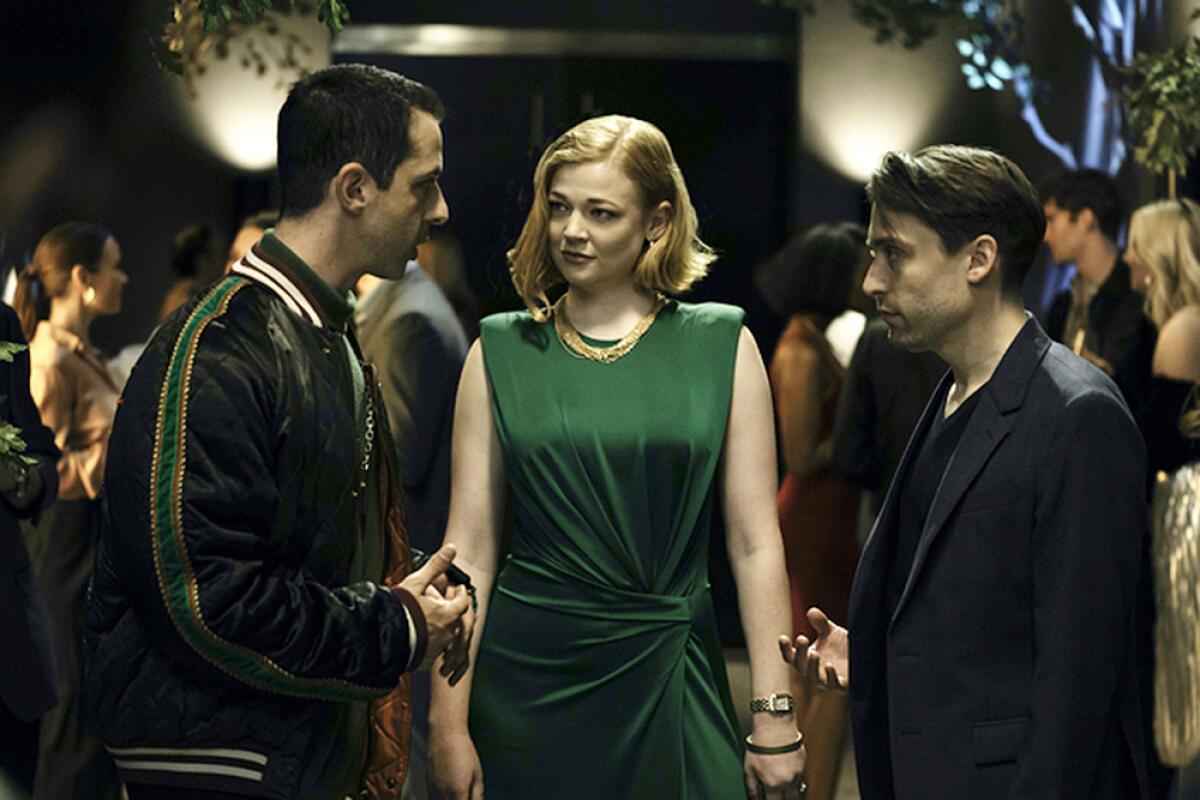
Is it 2022 yet? Asking for a friend. I’m Carolina A. Miranda, arts and urban design columnist at the Los Angeles Times and I’m in a fog. In addition to the usual psychological malaise triggered by capitalism and the pandemic, L.A. is rilly rilly foggy this week. But we’re all-weather here at Essential Arts, so, without further ado, here’s everything doing in the culture this week:
This great stage of fools
When the latest episode of HBO’s “Succession” debuted Sunday, it began with a song: Kendall Roy, the wannabe media scion (played by Jeremy Strong), sings Billy Joel’s “Honesty” while rehearsing for his bro-tastic 40th birthday party inside the Shed, a performance and arts space designed by Diller Scofidio + Renfro and located in Manhattan’s Hudson Yards development.
It is a birthday rife with over-the-top absurdity. Guests entered via a hallway designed to resemble an abstracted vaginal canal, after which they are “birthed” into the party. An oversized treehouse structure serves as a VIP section guarded by bruisers. A fake forest is studded with actors who deliver compliments to guests. One lounge is wallpapered with wall-sized video panels of flames that make the place feel not like a warm, toasty nook, but a roasting hellscape.
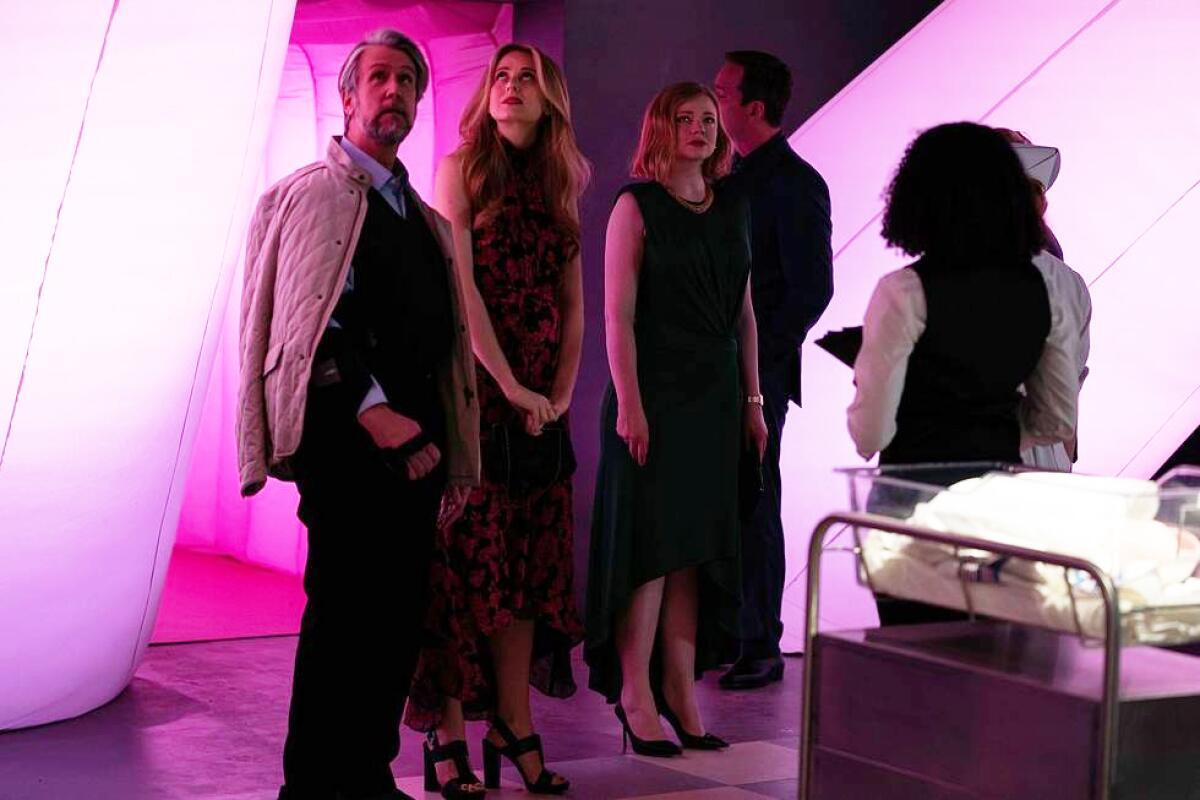
The party is lavish, but it leaves Kendall, who is in conflict with his siblings and his powerful father, empty inside — as empty, if not emptier, than when it began.
At the end of the night, he and his girlfriend, Naomi (played by Annabelle Dexter-Jones) retreat to his apartment in one of the gleaming towers that surround Hudson Yards. Standing on the deck, Kendall looks down at the plaza below, where he gazes into the void of the Vessel, architect Thomas Heatherwick’s $200-million staircase sculpture — which resembles not so much a vessel than a beautifully up-lit wastebasket.
“I think the party’s over, yeah?” Kendall says to Naomi.
It couldn’t be a more on-point. The Vessel has been closed since July, when a 14-year-old boy leapt to his death from the structure, the fourth such suicide in a year and a half.
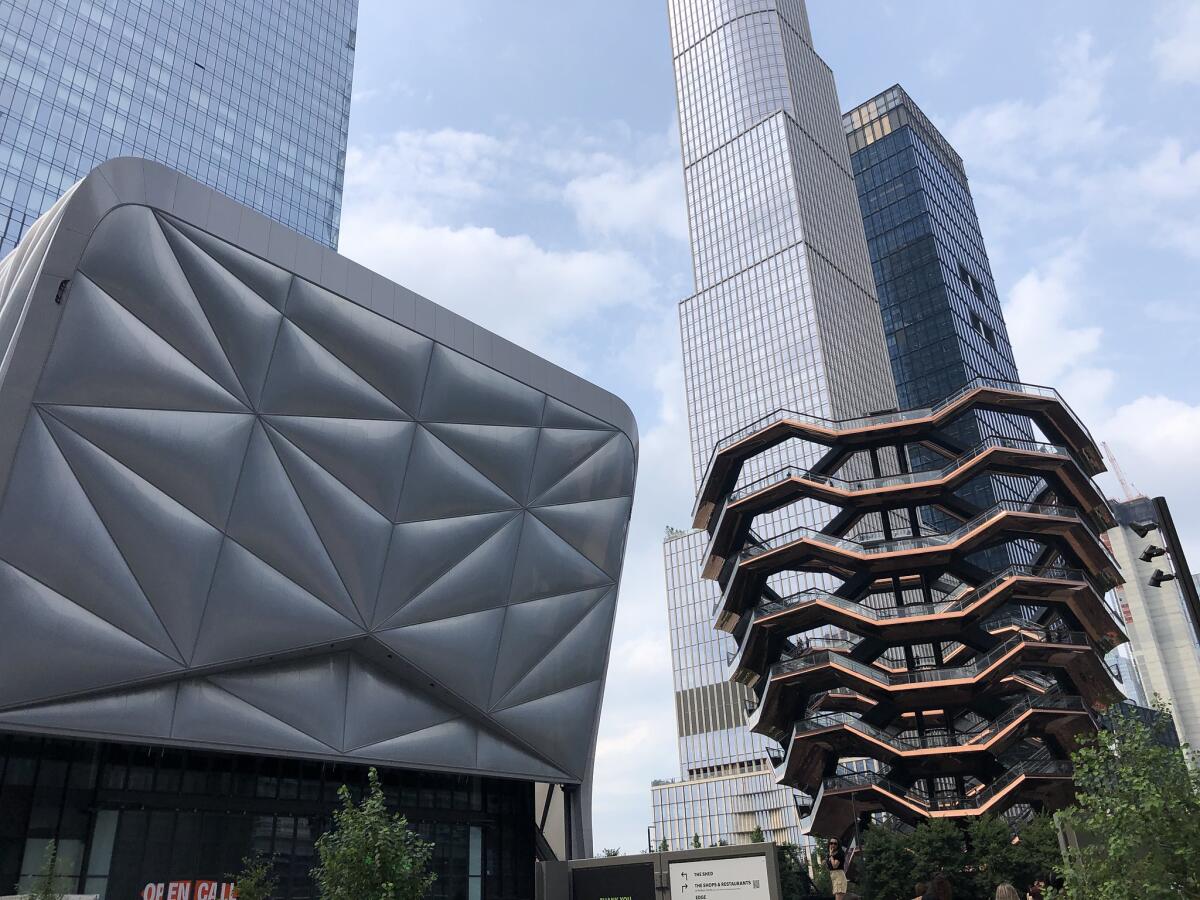
Interestingly, after “Succession” aired Sunday, Twitter seemed less focused on the plotline of Kendall’s ludicrous party than on the fact that his character lives in Hudson Yards.
“Of all the emotional exhaustion in last night’s Succession, the saddest part was knowing Kendall lives in Hudson Yards,” tweeted writer and podcaster B.A. Parker (@parkusfarce). “Every choice he makes for himself is a mistake.”
“it only makes sense that kendall lives and parties at hudson yards, manhattan’s most prominent hellmouth,” wrote a Twitter user named @small_jawn.
Alex Reid, a TV writer who tweets under the handle @botany500, astutely observed: “Kendall’s apartment is the best casting in Succession. He’s lost his soul and any real human connection with anyone around him, spiraling in a pitiless void of superficiality and obscene wealth. So what better place for him to live than Hudson Yards?”
The official website for Hudson Yards describes the $25 billion development as a “new neighborhood [that] has not only changed the way New York looks to the world, but the way the world sees New York.”
That may not be entirely untrue. But it hasn’t changed the ways the world sees New York in the ways the developer likely intended. New York has frequently served as a cinematic backdrop that conveyed a richness and texture of experience — for both good and ill. Hudson Yards has instead emerged as symbol of shallow hypercapitalism.
And Hudson Yards is on film what it is in real life — an assemblage of luxury shops, luxury apartments and luxury office towers buried under acres of glass, in a design so forgettable it’s a struggle to recall its profile in the Manhattan skyline without hitting Google for an image search.
Guardian critic Oliver Wainwright described the design as feeling “cheap,” in his review of the development shortly after it opened in 2019. That same year, Bloomberg CityLab reporter Kriston Capps revealed that the whole mega-project had been financed, in part, through a program intended to support unemployment in distressed urban areas.
To summarize: A luxury development that is actually a simulacrum of luxury was built with investment money intended to support investment in poor neighborhoods. It makes Hudson Yards the perfect setting for the fictional Roy family, who show little interest for anything that doesn’t involve hasty, ill-timed power grabs.
It’s not the first time the architecture of the place — and Heatherwick’s abominable Vessel — have been cast in this role. In “The Flight Attendant,” HBO’s murder caper from last year, Cassie, the show’s titular flight attendant, sneaks into an apartment in a Hudson Yards tower in an attempt to solve the mysterious killing of a wealthy businessman, a death for which she has been framed.
As she attempts to talk her way into the building, the personable Cassie (played by Kaley Cuoco) casually tells the building’s doorman that they won’t be long. “I do not want to be staring at that monstrosity any more than we need to,” she says as she waves her hand at Heatherwick’s Vessel.
It is monstrous, indeed. And it couldn’t be a better symbol for Hudson Yards, where the living and breathing city is sacrificed in favor of a thin patina of high gloss.
Make the most of L.A.
Get our guide to events and happenings in the SoCal arts scene. In your inbox once a week.
You may occasionally receive promotional content from the Los Angeles Times.
And because too much “Succession” is never enough:
Alison Herman, who writes about culture and television for the Ringer, has a smartly observed essay about the ways in which “Succession” depicts wealth. She notes that Hudson Yards serves as the ideal backdrop to a global elite who have little in the way of connection, sentimental or otherwise, to place. “Many of the criticisms leveled at Hudson Yards could also apply to the Roys themselves and the rarefied lives they lead,” she writes. “Their environs aren’t gilded or garish, but they are soulless, so devoid of texture and mess as to seem slightly inhuman.”
The soulless architecture, unfortunately, seems to have penetrated the makeup of the characters and the show’s narrative arcs. Times theater critic Charles McNulty reports that a program that once evoked the Shakespearean — intergenerational scheming and an angry patriarch in failing health — is now leaning more into cynicism à la David Mamet, leaving the Roy children to circle one another in a continuous vortex of backstabbing. This has marked “a drop-off in emotional substance,” writes McNulty. “What is left to sustain our interest in a Lear who lacks poetic majesty and four selfish scions without a speck of the principled goodness Shakespeare highlights in Cordelia?”

On and off the stage
The Tony-winning musical “The Band’s Visit” has landed at the Dolby Theatre. The show, about a group of Egyptian musicians stranded in an Israeli town, is based on a 2007 movie of the same title. Charles McNulty says it’s worth checking out. “Composer and lyricist David Yazbek infuses Itamar Moses’ book with lyrical poetry,” he writes. “Discreetly flecked rather than dolloped, music provides a vehicle of shared expression for grief, longing and hope — a universal language that recognizes no borders.”
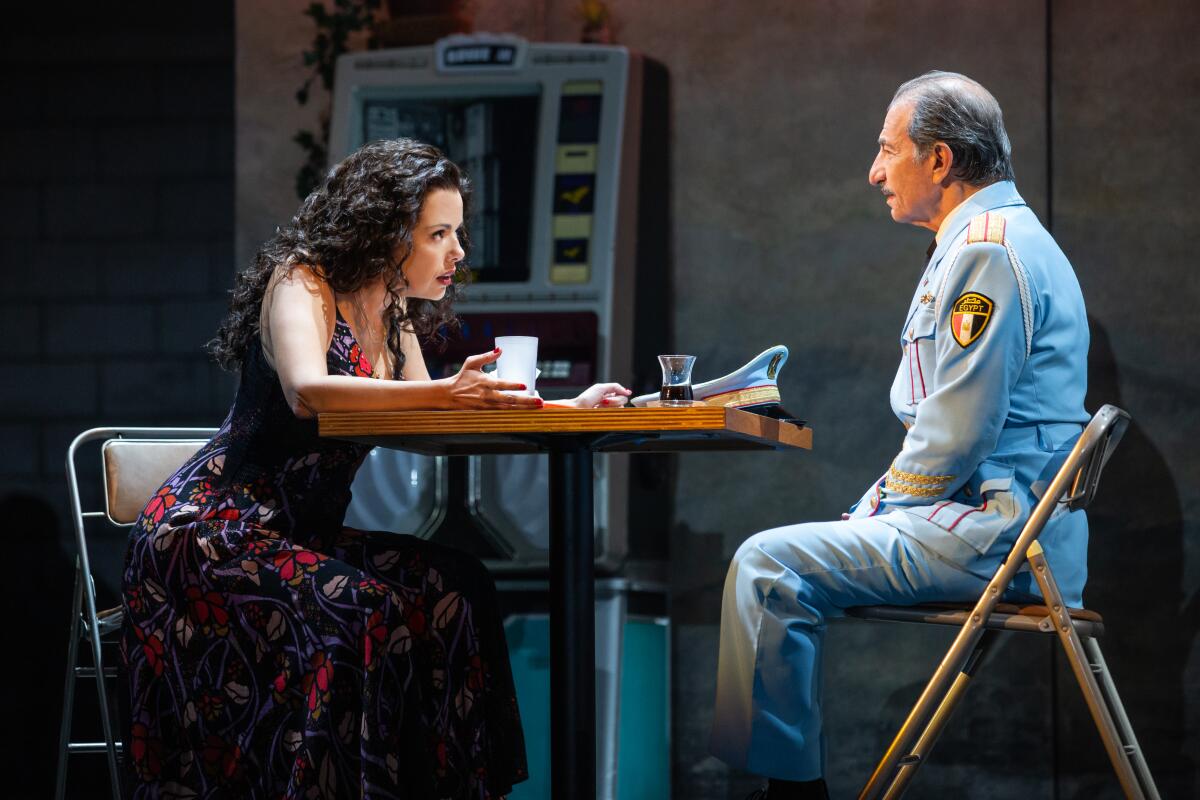
Playwright Dominique Morisseau withdrew her play “Paradise Blue” from the Geffen Playhouse after an unspecified incident involving a member of the production that she says the theater was slow to respond to. “There were Black women, some of them young, in and out of this process, whose eyes were on me, and they were watching the Geffen, and they were feeling small and powerless,” Morisseau told The Times’ Jessica Gelt. “And that’s when I stepped in.” In a social media post, the Geffen apologized: “An incident between members of the production was brought to our attention and we did not respond decisively in addressing it.”
Enjoying this newsletter? Consider subscribing to the Los Angeles Times
Your support helps us deliver the news that matters most. Become a subscriber.
The multiplayer online game “League of Legends” has inspired an animated series on Netflix called “Arcane.” Now the series has inspired a work of immersive theater, “Arcane: Enter the Undercity,” which is being staged at an L.A. warehouse. Our game critic Todd Martens checked it out, and while he was there, got propositioned and asked to show off his boxing ability. “It’s participatory entertainment, building upon a mix of theme parks, escape rooms and immersive theater,” he writes of the show, “and it succeeds in that it downplays reenactments from the series in favor of communal moments.”
Speaking of escape rooms, they’re back.
Remembering Sondheim
Over the Thanksgiving holiday, Stephen Sondheim, the award-winning composer and lyricist behind shows such as “Follies” and “Sweeney Todd,” who brought a greater complexity to stories told in the musical form, died at the age of 91. Over the course of his career, he won a rack of Tony Awards, as well as a Pulitzer Prize — the latter for “Sunday in the Park With George,” a collaboration with librettist James Lapine inspired by painter Georges Seurat’s most famous painting.
Of his work, Gary Gardner, the former chair of UCLA’s musical theater program, once said: “With [Oscar] Hammerstein, you felt wonderful when you left the theater. But with Sondheim, you realized the angst of living in the late 20th century.” Read the full Times obit here.
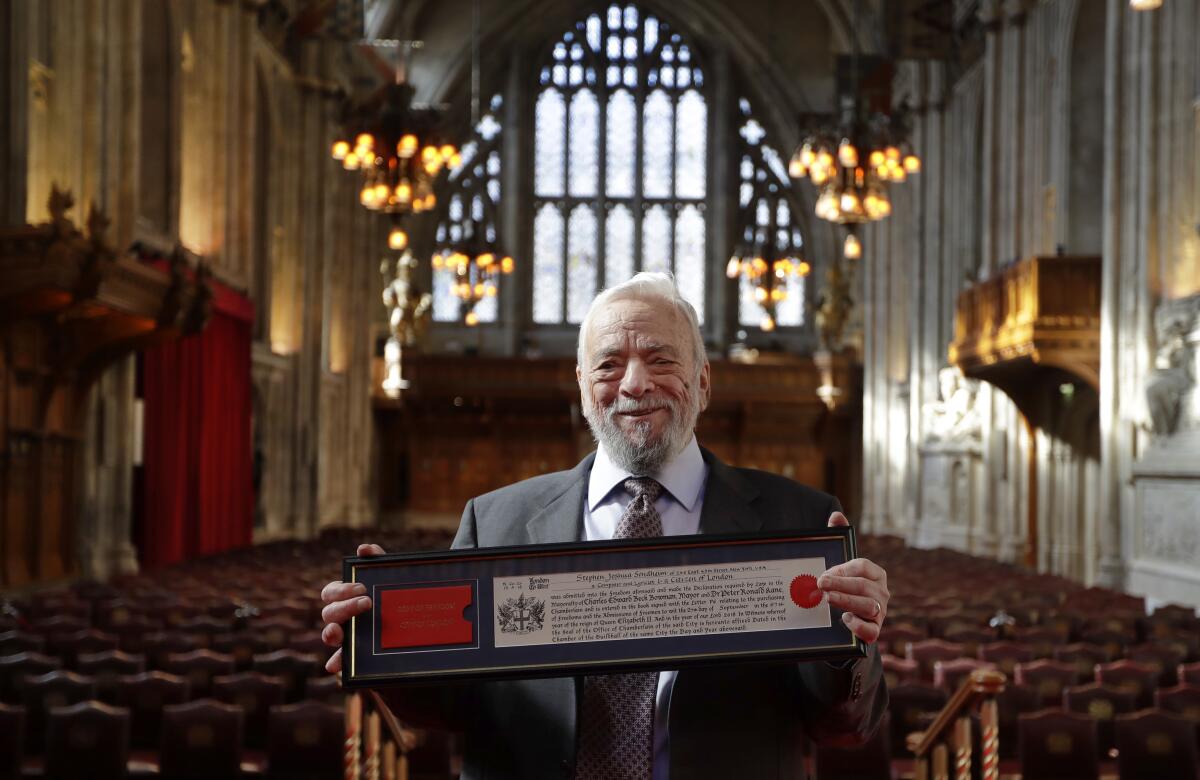
The magnitude of Sondheim’s death, writes McNulty, feels seismic. “Sondheim deserves a spot on playwriting’s Mt. Rushmore,” he writes, “for his contribution to the theater is as significant from a literary as it is from a musical standpoint. In truth, you can’t separate the words from the notes in his scores any more than you can pry apart form from content in his shows.”
Performer Josh Groban spoke with Times pop music critic Mikael Wood about why he has been such a lifelong fan of Sondheim’s work. “Steve’s work stimulated the intellect; it challenged you to think deeper about yourself and about the world,” says Groban. “At the same time, he could take your breath away with his music.”
Rachel Syme at the New Yorker writes about how Sondheim knew how to channel the grit of a woman who’s lived — a.k.a. the brassy dame. As she writes, “He never felt that women became obsolete in the theatre — not if you write them the songs.”
Times contributor Barbara Isenberg chats with five Sondheim collaborators to discuss what made his legacy so significant. “I always viewed Sondheim as a poet, even more than a lyricist or composer,” says choreographer and director Susan Stroman. “He was unmatched in his formation of phrase and rhyme, and he gathered words to make people think.”
Visual arts
Deborah Vankin has been hanging with Fabrizio Moretti, the drummer of the Strokes — who, it turns out, is also a sculptor. His latest work is currently on view at Sotheby’s in Beverly Hills: a sculptural installation that contains within it a work by Anish Kapoor. Vankin reports that “it looks like a glowing spaceship that’s crash-landed inside Sotheby’s clinically white gallery.” Moretti describes it as “a melted cube.”
Plus, Vankin also reports that Compound, a relatively new arts space in Long Beach, has been rattled by layoffs.
Artist Judy Baca is primarily known as a muralist and the artist who led the creation of “The Great Wall of Los Angeles” in the 1970s. A retrospective at the Museum of Latin American Art adds more dimension to her career. As part of a wide-ranging discussion, we talked about some of her lesser-known works, such as conceptual piece for a show at the Woman’s Building in 1976 for which she dressed up as a pachuca. “Back then, nobody cared about that show,” she told me. “Nobody wrote about it. Nobody spoke about it. It was like it never occurred. But it has started to get more attention recently.”
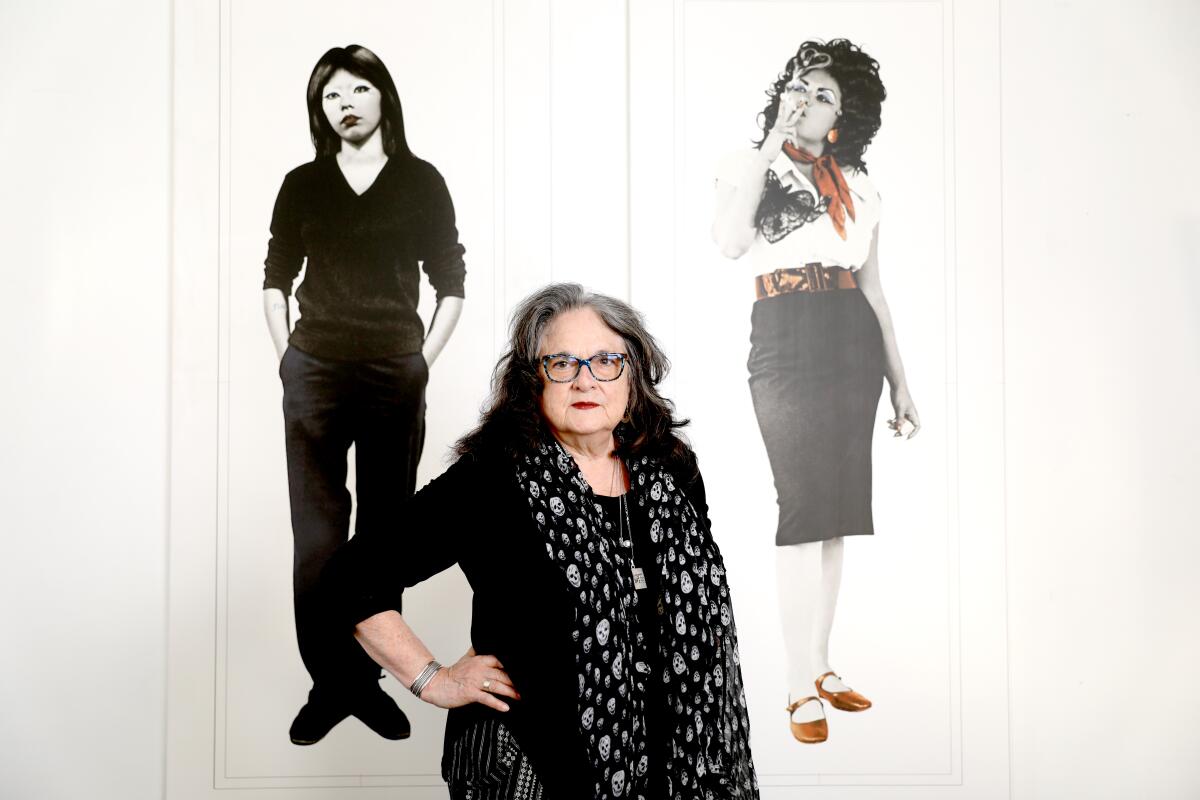
Essential happenings
Matt Cooper has all the museum exhibitions to see in L.A. and O.C. in December, including prop jewels from Disney films at the Bowers Museum and a show that mixes pre-Columbian artifacts and colonial painting with contemporary art at LACMA.
And since this season we’ll actually be able to enjoy some holiday action outside of the house, Cooper also rounds up the best holiday entertainment in SoCal. Need some Nutcracker, Scrooge or Grinch? We’ve got you covered.

Passages
Lawrence Weiner, a pioneering conceptual artist known for installations made of boldly designed words and phrases, has died at 79. If you have driven along Santa Monica Boulevard, you may have seen a work of his that for years appeared on the second story level of Regen Projects that read: “ABOVE BELOW THE HAZE.” It was recently replaced by another phrase by the artist: “WHATEVER WAS SOMEWHERE ELSE BEFORE.”
Bernard Judge, an architect who built a geodesic dome house in the Hollywood Hills, helped preserve the Schindler House and designed dwellings for Marlon Brando in the South Pacific, has died at 90.
Fashion designer Virgil Abloh, who infused the world of high fashion with casual ethos of streetwear, is dead at 41. In an assessment of his legacy, New York Times fashion writer Guy Trebay described Abloh as “prismatic, a designer capable of capturing the varied colors and lights of an evolving culture, refracting and then beaming them out to a waiting world.”
In other news
— L.A. artist Andrea Bowers is the subject of a career survey at the Museum of Contemporary Art Chicago (it will travel to the Hammer Museum next year). The New York Times’ Siddhartha Mitter profiles the artist he describes as “America’s most important political artist.”
— LACMA curator Christine Y. Kim is leaving the museum to join Britain’s Tate.
— The Hammer Museum has a new restaurant and it is being led by David Tanis, an alum of Alice Waters’ Chez Panisse. L.A. museums appear to be impervious to my lobbying for a churro cart. (It’s on you, Lucas Museum of Narrative Art.)
— Rob Walker on COVID’s design legacy.
— A fascinating look at what recent digs and shifts in archaeological practice are revealing about Pompeii.
— Jill Lepore has a great piece about the preservation of African American burial grounds in the U.S. It describes what sounds like a really compelling installation by artist Karyn Olivier that will mark a razed burial ground in Philadelphia.
— Josephine Baker will be honored in one of France’s most important sanctums: the Panthéon.
— An analysis of the state of contemporary Peruvian literature by Camila Osorio in El País. This story is a good reason to learn Spanish.
And last but not least ...
I’m here for industrial Instagram.
The biggest entertainment stories
Get our big stories about Hollywood, film, television, music, arts, culture and more right in your inbox as soon as they publish.
You may occasionally receive promotional content from the Los Angeles Times.




